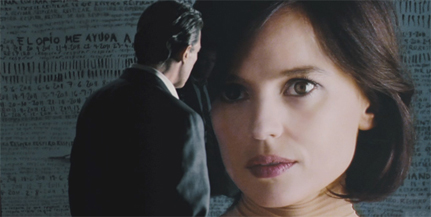Movie Review: The Skin I Live In
By Matthew Huntley
October 26, 2011
BoxOfficeProphets.com

The film opens on a petite young woman in an elongated stretch. Her name is Vera (Elena Anaya) and she’s practicing yoga while wearing a skintight body suit. She’s served food and other essentials by a housekeeper named Marilia (Marisa Paredes), who sends things up to her via a dumb waiter. Vera’s room is one of many in the mansion of Dr. Robert Ledgard (Antonio Banderas), a brilliant plastic surgeon in Toledo, Spain who has performed three facial transplants and calls them the most moving experiences of his life. Deep down, he knows how much a person’s face means to them.
Robert, a widower, has been sheltering Vera for quite some time and she’s become sort of his own personal project. Marilia, who is also Robert’s mother, alludes to what Robert is attempting to do with her and speaks against it. Robert and Vera’s back story is revealed in a lengthy flashback sequence, but I wouldn’t dare go into detail about it since some of the many pleasures of this movie are its surprises and revelations. And while it’s best to go into “The Skin I Live In” cold and unassuming, the story is so well told and seamlessly connected that not even spoilers can ruin it. It draws us in and holds us in spite of its twists, another mark of a strong story and an even stronger storyteller.
Early in the film we learn Robert has successfully cultured a new type of skin and has transplanted it onto Vera’s body. Through transgenesis, he’s combined human and pig cells to make the skin more impervious to burning and resistant to insects. At a medical conference, he tells his colleagues what he’s been working on but fails to mention he’s already using a human subject for testing. One doctor suspects illegalities at work and threatens to expose Robert if he doesn’t stop.
Now, based on what I’ve already told you, you may have some idea of where this story is going, but what’s intriguing about The Skin I Live In is it never stops taking new and unpredictable turns. And yet, they are turns we willingly accept, perhaps because Almodóvar doesn’t develop them along traditionally creepy or horrific lines, which they easily could have been. In this world, they are perfectly credible.
The first occurs when Robert’s half-brother, Zeca (Roberto Álamo), wanted for bank robbery and dressed in a tiger costume, shows up and sees Vera. An ugly incident ensues before the film delves into the histories of its two main characters. It transports us six years into the past when Robert was married and had a daughter. Eventually, separate tragedies will leave him grief-stricken and alone.
In a related subplot, we meet Vicente (Jan Cornet), a twentysomething mamma’s boy who works in his mother’s dress shop. He puts the moves on his lesbian co-worker, to no avail, before meeting Robert’s daughter, Norma (Blanca Suárez), at a wedding. Norma, still traumatized over her mother’s death, takes a walk with Vicente and he tries to have sex with her in the woods. What happens next is not exactly rape, but it’s also not consensual sex, either. The encounter worsens Norma’s sociopathic condition and Robert has no choice but to commit her to a mental hospital. It also leaves Robert vengeful toward Vicente.
More about the plot, I cannot say, except that all the characters and stories intertwine in ways that are probably unbelievable on paper but completely reasonable in the film. Even if I did reveal its secrets, The Skin I Live In is a rich experience beyond its narrative. On a production level, it’s one of best looking films of the year, composed of grandiose wide shots and detailed close-ups. Almodóvar’s longtime cinematographer, José Luis Alcaine, and production designer, Antxón Gómez, work together to create a multi-layered world where there’s almost always something interesting in frame. And the way Almodóvar films the action, either by holding on the characters as they walk from one end of the hallway to the other, or by having them slowly put on latex gloves, is strangely infectious and mesmerizing. These shots don’t just advance the scenes; they show the characters in their element.
There are other striking shots in the film, especially of Robert’s mansion, where he displays several paintings of human beings. Almodóvar contrasts the beauteous, artistic surroundings with the characters’ dark, inner turmoil, building on the theme that things on the outside sometimes have no bearing on the way we feel inside. Working from the novel Tarantula by Thierry Jonquet, Almodóvar, makes us realize emotions are malleable and can either change over time or instantly and they’re not always decipherable.
When viewed from a traditional point of view, with our usual, generic expectations in place, The Skin I Live In is weird and twisted, but once we realize it’s a film that goes out of its way to be bereft of things that are traditional and usual, it envelops us in a way few films do. It makes weird and twisted seem normal and challenges us to think outside our comfort zone. By the end, we see how emotions like anger, vengeance, lust and love can arise from the most unexpected places. It’s these places the film is willing to go.